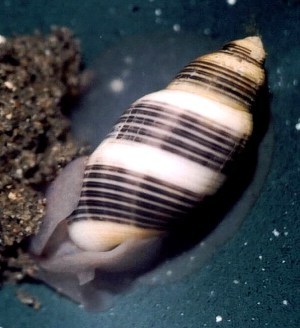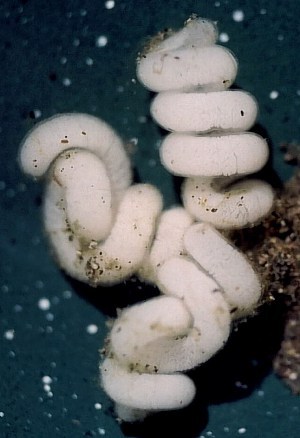Rictaxis punctocaelatus from central California
February 6, 2001
From: Jeff Goddard

Hi Bill,
Here is a photo of the shelled cephalaspidean Rictaxis punctocaelatus and its egg masses. I found them in a mixed rocky/sandy habitat on the protected outer coast just north of Cayucos, [central California, USA] on 23 November 2000. The egg masses were about 20 mm long and anchored in sand by a long thin anchoring strand; the adults were found buried just below the sediment surface. Both the adults and egg masses were fairly abundant, which was a treat for me, as this was the first time I had found this species.
To my knowledge, species of the aeolid genus Cumanotus are the only other opisthobranchs on the west coast of North America known to lay such distinctive spiral egg masses (the egg masses of Cumanotus, however, are considerably smaller than those of Rictaxis and are laid on hydroids in fouling communities).
The embryos of Rictaxis punctocaelatus hatched as small planktotrophic veligers with typical coiled shells 137 microns long. As with other members of the Acteonidae (but not members of most other families of cephalaspideans), these veligers did not have pigmented mantle organs.
Best wishes,
Jeff
goddard@lifesci.ucsb.edu


Thanks Jeff,
Your photos reminded me that I have some photos of another acteonid, Pupa strigosa, to post on the Forum.
Best wishes,
Bill Rudman
Related messages
-
Rictaxis punctocaelatus from California
From: Jim Lyle, July 6, 2005
